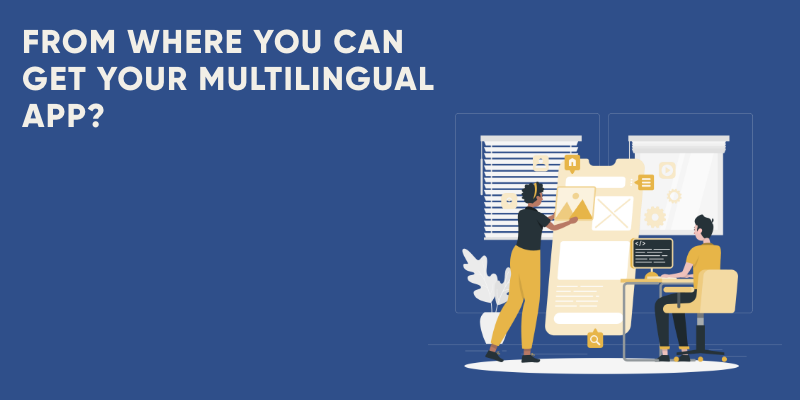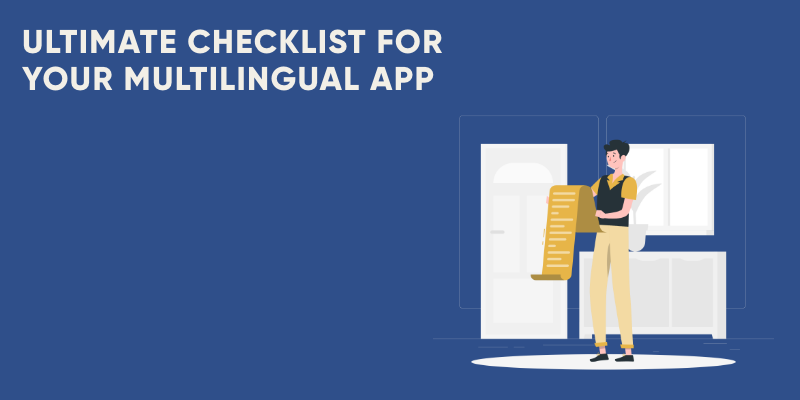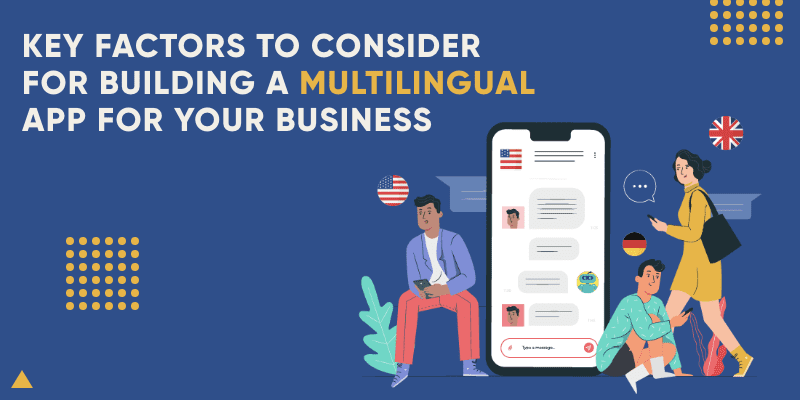Businesses are no longer bound to their local area in today’s global world. They are becoming more widely available on a global scale, reaching every nook and corner of the globe. This is made feasible by a multilingual app for business that allows you to communicate with anyone on the planet and meet their demands.
When it comes to global business, one aspect that plays a critical part in business success is language. Because you are already aware that English is not the native language of everyone on the planet, it is likely that your software will fail to serve non-native English speakers. Your company’s reach and earnings may become low as a result of this.
“According to SIL International’s Ethnologue 2017 edition, only 983 million individuals are able to speak or understand English.”
So, what’s the best way to cope with this situation? How can non-native English speakers be entertained? According to our professionals, the best appropriate solution for these problems is a Multilingual app – the most important strategy for Mobile App Localization.
What Does Multilingual Mean?

Multilingual mobile apps, as the name suggests, are apps that work in more than one language. Businesses may reach new markets and provide a tailored experience to their customers by using content that is driven by the appropriate mobile app localization strategy. It aids in the maintenance of transparency and mobility. It also serves as a tool for a purposeful, results-driven strategy to assure higher revenue and ROI.
“After being localized for the Taiwanese market, Clash of Clans became one of the top-grossing mobile applications of the year 2016.”
Multiple languages can exist in a country or region. In Canada, for example, people speak both English and French. To enhance the number of downloads, a wise business would launch its application in both languages. Multilingual apps perform substantially better than single language apps, according to case studies and surveys. People like to utilize the Internet in the language of their choice. According to a poll conducted by Common Sense Advisory,
- 1% of users spend the majority of their time on websites in their native language.
- A product providing information in their native language is more likely to be purchased by 4% of customers.
Multilingual mobile app development is popular since practically every company wants to do business in different regions of the world and enjoy the benefits.
Why Is A Multilingual App Important?
It will increase your visibility
App localization increases your app’s chances of being featured on any app store, particularly iOS and Android. Candy Crush Saga, for example, comes with the option of multiple languages, making it easier for app downloaders to read the terms and conditions before agreeing to them, comprehend the app’s start-up steps, and decode instructions, achievement notifications, and promotions that appear on the app’s start-up.
The more user-friendly an app becomes through the process of localization, the more likely it is to be downloaded from the App Store. You can attract overseas users and purchasers for your app and promotional merchandise by localizing an app store listing for your chosen product or software.
Helps to grow business globally
Businesses must acknowledge that not all of their potential customers are from English-speaking nations. The majority of the world’s population does not speak English as their first language.
Languages can operate as a catalyst or a barrier, depending on your audience and business location. You may assure maximum coverage and remove any demographic obstacles that may occur due to language problems by creating a multilingual website.
A local business can quickly grow into a global business with the support of multilingual marketing efforts. A multilingual app strategy can help your company reach a much bigger demographic and attract new clients from all over the world. When done correctly, globalization may propel your company to new heights.
Increase the sessions spent by the visitors on your application
Most people who speak multiple languages prefer to communicate in their first language, and they are more comfortable with and inclined to internet content written in their first language. This aids brands in establishing a trusting relationship with their customers.
Furthermore, a company that offers marketing content in languages other than English demonstrates that it is attentive to language barriers and caters to the needs of all of its users. It results in a strong bond between the brand and its customers. This leads users to spend more time on your application.
Enhance customer conversation
You’ve already had a bad customer service encounter because of your language. Imagine having to solve a problem in a language you don’t know. Isn’t it a bummer?
It can be a very stressful situation for both the agent and the customer when language becomes a barrier. Multilingual customer care comes into play here. You can serve everyone if you have a variety of content.
It turns the potential customer into a real purchase and repeats business
Companies often overlook the fact that great businesses thrive through word of mouth. Word of mouth is a significant, though underappreciated, channel for increasing acquisition.
But wait, how do lead generation and multilingual customer service go together? It’s as simple as that: by providing multilingual customer support, you’ll be able to serve information in multiple languages. You’ll obtain more visibility connected to the intent that drives awareness for your business if you’re indexed by search engines.
From Where You Can Get Your Multilingual App?

But wait, how do lead generation and multilingual customer service go together? It’s as simple as that: by providing multilingual customer support, you’ll be able to serve information in multiple languages. You’ll obtain more visibility connected to the intent that drives awareness for your business if you’re indexed by search engines.
Use a multilingual theme or by making your existing theme multilingual
This has been one of the most effective solutions in recent years. However, there are some important drawbacks:
- There are only a few options: Few agencies create multilingual themes, with Blackbelt Commerce being the most well-known—though they stopped doing so in 2016 and discontinued their iconic Bilingual Theme.
- Managing various posts and pages is quite difficult.
- There are no email/checkout translations available.
Using a multilingual app
A lot of new software technology has been developed in the previous few years that has enabled a variety of translation possibilities. I’m certainly biased as the co-founder of one of these applications, but I believe that having an app or service dedicated to a single feature within a website is sometimes the best option for particular requirements.
How To Create A Content Strategy For Your Multilingual App?
We have come up with a quick step-by-step guide for creating a Multi-Language app content strategy for you. When constructing a strategy for each language, you can use these steps as a guide.
Marketing Goals and Research
- Establish a smart strategic target.
- Locate the right target audience based on market research.
- There are no email/checkout translations available.
- Determine competitors on the basis of market analysis.
- Find out what possibilities and trends your competitors are using.
- Identify micro-segments and niches.
- Determine the micro-language segments and write content in that language.
Content Goals and Research
- Make a list of keywords that are relevant to your website and the people who will be visiting it.
- Identify broad issues that match your website’s theme and the language of your target audience.
- Make a content creation and maintenance budget.
Content Deployment and Maintenance
Create and outsource content that is especially for your audience. Promote the content through appropriate media sources. These stages serve as a short checklist to assist you in designing your strategies. You’ll notice that content is dynamic as you begin to work on your strategies. Even if trends change, your approach will act as a foundation for your work.
Key Factors To Consider While Building A Multilingual App For Your Business
Cultural Sensitivity
Cultural sensitivity refers to being aware of cultural aspects that might influence how you operate your business, advertise your brand to customers, and even establish relationships. Identifying the cultural nuances of audiences in a particular market will be crucial to how you navigate your online user experience, create marketing messages, and develop relevant products and services for local consumers if you want to stay relevant to international consumers and add value to your brand.
You must be aware of more than just slang phrases and idioms. Adapting your information to be culturally sensitive might range from changing the copy to match the market’s cultural requirements to completely changing your marketing strategy.
When you have a localized website, it’s usual to practice adapting photos to represent the culture of the market — for example, employing Chinese models and influencers for product pages on your Chinese site can be really effective.
Customized marketing efforts for certain regions can have a significant impact on how customers interact with your business online.
If you want to stay competitive, avoid clichés and obvious stereotypes and invest in taking the time to genuinely understand the subtleties of the business. If you get cultural sensitivity right, you’ll create the groundwork for fostering local client loyalty, as well as avoiding potential marketing gaffes and the ensuing backlash.
International SEO
Great multilingual SEO responsibility comes with great website localization. You’ll need to create an efficient multilingual SEO strategy to drive visitors to your website and improve sales in your target market.
Your international search strategy, like localizing your website, would need to include the linguistic and technological requirements for serving the proper pages of your website in search engine results pages to the right users in the relevant market.
To begin, you’ll need to collaborate with a language service firm that has an in-depth understanding of the local market, as well as one that uses native linguists to ensure that your domain name is market-appropriate.
When P&G launched Vicks in Germany, it learned that Germans pronounce “v” as “f,” converting Vicks become a slang term for sexual intercourse. That’s not the ideal method to break into a new market with your brand!
Technicalities:
After that, there’s the domain and URL structure to think about. If you’re going after a specific market, a Country Code Top Level Domain (ccTLD) can be the way to go. Search engines interpret domains like yourbrand.de and yourbrand.fr as indications that these sites should be served to users in Germany and France.
Keep in mind that ccTLDs are distinct domains. As a result, they’re frequently time and resource-intensive because they have to be set up and maintained independently from your domestic website. To ensure optimizing effectiveness, ccTLDs will require additional resources for PR, link building, and content marketing for each domain in their particular market.
Finally, there are subdomains and third-level domains, such as de.yourbrand.com, where localized content is housed on servers in the target market. This reduces page load times dramatically, which can have a significant impact on user experience and SEO.
When it comes to content like product descriptions and blog posts, make sure to include localized keywords and generate information that is tailored to your target audience’s interests and behavior. Machine translation systems, such as Google Translate, will be unsuccessful in translating your keywords.
Working with a reputable language service provider with native in-country linguists will assist you in navigating technical SEO so that your localized website can properly serve users in your target market.
Payment Methods
Whether you’re a luxury brand or a small shop, displaying pricing in local currencies and accepting local payment options is critical to your international success.
You should give cross-border customers the proper landed costs, including shipping, duty, and taxes, based on their market. Failure to convey these extra expenses can lead to a frustrating customer experience, resulting in a high return rate and a negative impact on your bottom line. For a smoother purchase experience, make sure you define the whole final price with calculations for any duty or taxes.
Remember that internet buyers are more knowledgeable than ever about currency rates and can easily detect if you’re purposely underpricing things.
Technicalities:
Choosing the appropriate payment option for each market should be high on your priority list as well. While Visa, Mastercard, and American Express are used in the West, cash on delivery (COD) is common among online buyers in emerging regions such as the Middle East, Africa, and India. Although reports imply that COD orders may decline post-Covid, this payment option is expected to remain popular in the future.
Other markets, on the other hand, have embraced the ease of eWallets in the same way that Apple Pay, PayPal, and GooglePay have in the West. WeChat (as part of Tencent’s TenPay) and Alipay dominate the Chinese mobile payment business, while Paytm controls more than half of the Indian market, and countries in Southeast Asia have a plethora of competitors.
ASOS and Burberry, for example, have made tremendous progress in the Chinese market by optimizing payment alternatives that allow shoppers to buy things using WeChat Pay and Alipay. Zara goes above and beyond in this market by providing a cash-on-delivery alternative.
Knowing which mobile payment service to apply to which market will be critical in avoiding any friction during the checkout process, as mobile payment services are expected to account for 50% of worldwide eCommerce sales by 2022.
Times and dates
To eliminate any misunderstanding or confusion, it is highly suggested that dates and timings be displayed in the desired local format. The disparity in date formats between the United States and the United Kingdom is one of the most noticeable examples.
If you deliver an order to one of your eCommerce customers on 11/8/22, a UK user will receive it on August 11, 2022, while a US user will receive it on November 8, 2022. The date in Japan, on the other hand, has the format of year/month/day. If we utilize the aforementioned delivery date, consumers in Japan can anticipate their package to arrive on August 21, 2012. To say this scenario is confusing is indeed an understatement!
Make sure you localize dates for each market on your website to avoid any confusion. Fortunately, the 24-hour system is widely used all over the world, with the exception of the United Kingdom and Thailand, which utilize both 24- and 12-hour formats. This is primarily owing to the lack of a translation for AM and PM in most languages. It’s also worth noting that some nations, such as Germany and Finland, use a full stop (.) rather than a colon as a separator (:).
Customer service
If you provide products or services online, your customers need to know that you’ll be there for them when they need it. If you provide assistance in their native language, you have a better chance of exceeding their expectations and improving your foreign clients’ lifetime value.
According to Common Sense Advisory, 74 percent of customers are more likely to buy from a firm that provides customer service in their native language. Furthermore, according to an ICMI survey, “assistance in a customer’s native language boosted their satisfaction with the customer care” for over 70% of customer service leaders. Furthermore, 58.4 percent indicated it strengthened their brand loyalty.
Localizing your customer care plan should include multilingual phone, email, and live chat. ASOS, a leading online retailer, offers help to its international consumers in Spanish, German, Italian, and French via phone (with local phone numbers), email, and live chat. This comprehensive approach to multilingual customer service gives European customers peace of mind, knowing they can contact the UK-based store in a variety of methods to speak with someone in their own language.
Technicalities:
You’ll also need to pay close attention to issues like returns and refunds that arise after purchase. Cross-border clients are well aware that this will take a little longer than local competition, but ensuring that there is as little friction as possible during this process will be critical to enhancing customer happiness.
While some multinational brands, such as H&M and Zara, have the ability to offer free returns through a local store, others do not. To provide a timely, dependable, and cost-effective delivery and returns service to their foreign clients, smaller companies must connect with logistics partners who have a strong local infrastructure.
For firms, expanding into the worldwide market can be extremely difficult. Effectively reaching clients in global marketplaces necessitates not only time and resources but also a thorough cultural awareness of each area. A successful localization strategy that considers all of these factors has a considerably better chance of global expansion success.
Address and contact format
Have a look at the customer service page or footer of a commercial website in another nation or language to see how the conventions for presenting addresses and phone numbers differ.
Take, for example, the North American continent. Country code 1 for phone numbers in the United States, Canada, and Mexico. However, depending on the area, phone numbers are in a different format.
In the United States and Canada, English speakers dial (302)1234567 or international +1302 1234567. However, in the Canadian province of Quebec, where French is the primary language, the Office québécois de la langue française considers the official format to be 1 NPA NXX-XX, with spaces first and then a hyphen for the last sequence. XX.
In the same way, Spanish-speaking Mexico has a different format. For local audiences, fixed lines are frequently written as XXX XX XX and XXXX XXXX, with or without dashes between the segments, based on the length. Almost every country in Europe has its unique length and formt.
Technicalities:
The issues of localization are the same when it comes to addresses. Of course, there are clear distinctions in terminology, such as Zip Code vs. Postcode, but there are also substantial changes in the format and structure of actual addresses in different nations.
In French, for example, the company name appears online, followed by the street address (line two), the postal code, the city name (line three), and the nation (line four). However, in Italy, the door number is normally written after the street name on the second line, with the postcode appearing first on the third line, followed by the town, and finally the two-letter provincial abbreviation.
In several places, users may have relatively simple addresses with only two or three lines. A street name, complex name, block number, floor, suite, or door number, as well as the town, principality, and zip code/postcode are all possibilities.
Include the language button and Maintain the selected language
Buyers will be able to traverse the site more easily if there is a configurable language button that matches the website’s style and feels.
Make sure your language button is visible to your visitors in a matter of seconds. You can place it at the top of your page. Also, you can make it a sticky button that stays in place as users explore. Finish it off with your own personal touches to ensure it matches the rest of your website’s design.
There are some places on your website where a language button isn’t appropriate. The sections with expandable features like a live chat window or a helpdesk beacon. It’s probable that the language button will be hidden underneath it It will be impossible for visitors to see that the store is in multiple languages. Finally, they may choose to abandon your website and not return.
The chosen language must be the same as visitors move from the top of your acquisition funnel to the bottom. It’s much more important for internet retailers, who must establish trust with their customers. If the language changes between pages, visitors may abandon the site before reaching the payment page.
Optimizing User Experience
For online businesses, the user experience is important. Whether you’re selling software or hardware, you must manage your visitors’ path to prevent missing out on crucial sales possibilities.
Multilingual apps are no exception. There are three important principles to remember:
- A language button
- A redirect option
- Maintaining the selected language
Set up a language auto redirection option to display the visitor’s language automatically. This will reduce the number of steps your visitors must do. The less work your visitors have to do to access the information they need, the longer they will stay on your sit. Remember, most people only stay on a website for less than 30 seconds. Use this option even if you chose a clear and visible language button.
Set up your automatic language redirection system without using IP geolocation. IP geolocation tracker tools are not always accurate. Also, consider Switzerland, Canada, or tourists: a nation is not a language. The ideal method to take advantage of the redirection capability is to base it on the visitor’s browser’s selected language. It’s more reliable because users put up with it.
Including translation sources in your coding
Make certain that your source code includes translations, i.e. on the server. It can happen simply on the server-side, or it can happen on both the server and the client-side. Otherwise, Google and other search engines will crawl your page and find unique content under a different language’s specific URL.
This could have two undesirable consequences:
- The original language will display in the search results.
- Because the scanning and indexing of the same information will take place under two different URLs, resulting in duplicate content.
Don’t expect search engines to be able to crawl Javascript. For the time being, testing demonstrates that. Even if Google makes major improvements, it will still fall short of server-side content. It’s normally only possible if you employ a pre-rendering solution, which is usually provided by a third party.
So, while you’re seeking multilingual solutions, double-check that the elements listed above are supported and incorporated into the features.
Unless you don’t care about SEO, avoid inferior solutions like solely using Javascript. And while we’re on the subject, find out what a canonical URL is and why it’s so crucial.
Multilingualism has an impact on the visitor’s journey, You should also consider the entire experience provided by your multilingual application.
Emails and Invoice
Emails are an important part of every e-commerce business. They’re a low-cost, high-impact marketing and communication tool. Newsletters abandoned cart notifications, and confirmation emails are some of the most common applications.
If you have a multilingual app, email writing should be in multiple languages too. As a result, the email sending command must correspond to the visitors’ language.
Although invoices are more essential for B2-B firms than for B2C businesses, bookkeepers frequently require them. They’re also the last step in the purchasing process, and hence the end of the user experience.
While other important aspects of invoicing, such as multi-currency and country-specific tax, may be handled with tools like Sufio, clients prefer their invoices must be written in the same language as their purchase.
Ultimate Checklist For Your Multilingual App

To get started with a multilingual app, here’s a simple checklist for you:
- Which languages do your consumers speak?
- How did the information gathering procedure look?
- What do each culture’s customer service expectations look like?
- At what time are customers can suppose to contact me?
- For those languages, what is the form of our longtail?
Once you’ve answered all of these questions, you can begin to develop your customer service strategy.
Conclusion
In this age of globalization, ignoring the non-English speaking peoples of the world might be a costly error. Instead, if making an effort to make an app available in multiple languages, you will be well on your way to making your company a brand.
Apart from the above-mentioned considerations, there are a number of other factors to consider while developing multilingual mobile applications. Remember, it’s a cost-effective way to expand your business into new countries and increase user retention rates around the world. It is, in fact, one of the most popular topics in the app world. So, give app creation your all and watch your business bloom!
So, have you created a multilingual app yet, or are you planning to do so soon? Echoinnovate is the most reliable and trusted app development company. Get in touch with our experts today!
FAQs
What Is A Multilingual App?
A multilingual app uses more than one language. We can alter the language in a variety of locations, as indicated below. During the registration process, you can choose your preferred language. On the common header, where you can change the language at any moment. In the user preferences section
What Is the Importance of a Multilingual Setup?
To serve your users and modern business, you must have a multilingual setup. You may build a nurturing relationship with your user by communicating with them in the language of their choice, which leads to easy conversion. With a multilingual app, you can reach a larger audience. It makes it easier for consumers from all over the world to see and comprehend your services and information. Reduce your drop rate by allowing people who don’t speak or understand your language to quickly alter the language of the app’s content. Improve your ranking on the international Search Engine Results Page (SERP) (SERP). SERPs rank you higher since you can provide content that connects to a broader audience. Multilingual support will help you improve your brand’s image and recognition.
From where you can get your multilingual app?
Use a multilingual theme or by making your existing theme multilingual Using a multilingual app



